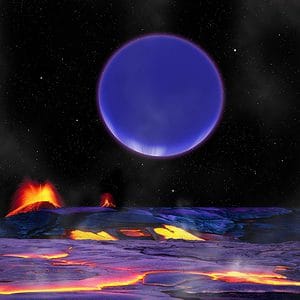Kepler, a space telescope on a mission to find alien planets by measuring dips in the brightness of more than 150,000 stars, has come across a fantastic discovery. Two planets orbiting a distant star, which are closer to one another than any other two planets discovered thus far. Apparently, from the surface of the smaller planet, its neighbor would appear about the size of a 2.5 full-moon, while from the surface of the bigger planet, its dance partner would be the size of a full-moon. Indeed, this is a REAL SciFi scenario.

Artist impression shows a beautiful, purple Kepler-36c dominating the skyline, as seen from the surface of the smaller Kepler-36b. CLICK for a magnified view. (c) David Aguilar, Harvard-Smithsonian Center for Astrophysics
The newly found planets are located in a system 1,200 light-years from Earth. Kepler-36b is a rocky world measuring 1.5 times the radius and 4.5 times the mass of Earth, while Kepler-36c is a gaseous, Neptune-size world about eight times as massive as Earth. Kepler-36b orbits its star every 13.8 days, and Kepler-36c every 16.2 days, and at their closest, the two planets come just within about 1.2 million miles of each other. That’s only five times the Earth-moon distance and about 20 times closer to one another than any two planets in our solar system.
“These two worlds are having close encounters,” said Josh Carter, a Hubble Fellow at the Harvard-Smithsonian Center for Astrophysics, in a press statement.
“They are the closest to each other of any planetary system we’ve found,” said the report’s co-author Eric Agol of the University of Washington in a press statement. “The bigger planet is pushing the smaller planet around more, so the smaller planet was harder to find.”
Twin planets trapped in an odd dance
Were these planets to house an atmosphere similar to that of the Earth, a view from any of the two’s surface would surely seem divine; especially from the Kepler-36b, where Kepler-36c would appear in the night sky 2.5 times bigger than our full moon. Sadly, the planets are so close to their sun, that nothing could survive, and their atmosphere, especially that of the gaseous Kepler-36c, would most likely obstruct any attempts at peering outside the worlds.
“Planet c would appear roughly 2.5 times the size of the full moon when viewed from the surface of planet b. Conversely, planet b would appear about the size of the full moon on planet c,” Carter said.
“We can speculate on the appearance of planet c: It may appear slightly more purple that Neptune,” he added. “The purple hue owes to absorption of red and yellow by sodium and potassium. There could also be a slight brown tint owing to hazes of photo-disassociated methane.”
The team of researchers from the University of Washington and Harvard University, published their findings in the journal Science.









